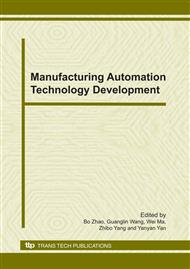p.47
p.52
p.59
p.66
p.72
p.76
p.81
p.87
p.92
Thermomechanical Finite Element Simulation of Cutting Force and Temperature in Ultrasonic Aided Turning of Hardened Steel
Abstract:
Compared with conventional turning (CT), ultrasonic aided turning (UAT) demonstrates many advantages in turning of hardened steel. In the paper, UAT is studied with finite element (FE) simulations and compared with conventional hard turning according to simulation results. Based on the thermo-elastic-plastic finite element equation for simulating the metal orthogonal cutting process, the paper introduces two-dimensional thermomechanically coupled FE models with and without ultrasonic assistance by means of MSC.MARC FE software. And the differences of cutting force and temperature distribution in the process zone between conventional and ultrasonic hard turning are investigated. Research results show that the mean cutting force and temperature in UAT are smaller than those in CT, UAT is an suitable method for precision turning of hardened steel.
Info:
Periodical:
Pages:
72-75
Citation:
Online since:
December 2010
Authors:
Price:
Сopyright:
© 2011 Trans Tech Publications Ltd. All Rights Reserved
Share:
Citation:


